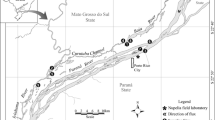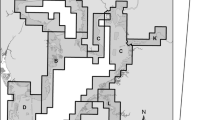Synopsis
Scale circuli of juvenile weakfish,Cynoscion regalis, were counted to determine if deposition was daily. Scale circuli counts were precise with little variation between counts (99% of the two counts from an individual scale were identical, N = 3580). Tetracycline marked juveniles (N = 71) had mean scale circuli deposition rates that were daily up to 24 d after marked. Data from several sources suggest that daily deposition of weakfish scale circuli occurred over a relatively narrow size range, approximately 14.3 to 111.9 mm standard length, however it is during this time that juvenile weakfish occupy estuarine nursery areas, where growth, mortality, and survival may alter subsequent year class strength. The estimated upper size limit at which scale circuli were no longer daily occurred over a wide range (82–142 mm standard length), and additional research is required to further clarify the limits of size and age of daily circuli deposition.
Access this article
We’re sorry, something doesn't seem to be working properly.
Please try refreshing the page. If that doesn't work, please contact support so we can address the problem.
Similar content being viewed by others
References cited
Barber, W.E. & R.J. Walker. 1988. Circuli spacing and annulus formation: is there more than meets the eye? The case for sockeye salmon,Oncorhynchus nerka. J. Fish Biol. 32: 237–245.
Campana, S.E. & J.D. Neilson. 1982. Daily growth increments in otoliths of starry flounder (Platichthys stellatus) and the influence of some environmental variables in their production. Can. J. Fish. Aquat. Sci. 39: 937–942.
Campana, S.E. & J.D. Neilson. 1985. Microstructure of fish otoliths. Can. J. Fish. Aquat. Sci. 42: 1014–1032.
Campana, S.E., J.A. Sagne & J. Munro. 1987. Otolith microstructure of larval herring (Clupea harengus): image or reality? Can. J. Fish. Aquat. Sci. 44: 1922–1929.
Chao, L.N. & J.A. Musick. 1977. Life history, feeding habits, and functional morphology of juvenile sciaenid fishes in the York River Estuary, Virginia. U.S. Fish. Bull. 75: 657–702.
Davies, N.M., R.W. Gauldie, S.A. Crane & R.K. Thompson. 1988. Otolith ultrastructure of smooth oreo,Pseudocyttus maculatus, and black oreo,Allocyttus sp., species. U.S. Fish. Bull. 86: 499–515.
DeVries, D.A. & M.E. Chittenden, Jr. 1982. Spawning, age determination, longevity, and mortality of the silver seatrout,Cynoscion nothus, in the Gulf of Mexico. U.S. Fish. Bull. 80: 487–500.
Doyle, R.W., A.J. Talbot & R.R. Nicholas. 1987. Statistical interrelation of length, growth, and scale circulus spacing: appraisal of a growth rate estimator for fish. Can. J. Fish. Aquat. Sci. 44: 1520–1528.
Healey, M.C. 1982. Timing and relative intensity of size-selective mortality of juvenile chum salmon (Oncorhynchus keta) during early sea life. Can. J. Fish. Aquat. Sci. 39: 952–957.
Jenkins, G.P. 1987. Age and growth of co-occurring larvae of two flounder species,Rhombosolea tapirina andAmmotretis rostratus. Mar. Biol. 95: 157–166.
Kendall, A.W., Jr., M.E. Clarke, M.M. Yoklavich & G.W. Boehlert. 1987. Distribution, feeding, and growth of larval walleye pollock,Theragra chalcogramma, from Shelikof Strait, Gulf of Alaska. U.S. Fish. Bull. 85: 499–521.
Lotrich, V.A. & W.H. Meredith. 1974. A technique and the effectiveness of various acrylic colors for subcutaneous marking of fish. Trans. Amer. Fish. Soc. 103: 140–142.
Lough, R.G., M. Pennington, G.R. Bolz & A.A. Rosenberg. 1982. Age and growth of larval Atlantic herring (Clupea harengus L.) in the Gulf of Maine — Georges Bank region based on otolith growth increments. U.S. Fish. Bull. 80: 187–199.
Neilson, J.D. & G.H. Geen. 1985. Effects of feeding regimes and diel temperature cycles on otolith increment formation in juvenile chinook salmon,Oncorhynchus tshawytscha. U.S. Fish. Bull. 83: 91–101.
Nishimura, A. & J. Yamada. 1988. Geographical differences in early growth of the walleye pollockTheragra chalcogramma, estimated by back-calculation of otolith growth increments. Mar. Biol. 97: 459–465.
Pannella, G. 1971. Fish otoliths: daily growth layers and periodical patterns. Science 173: 1124–1127.
Rice, J.A. 1987. Reliability of age and growth-rate estimates derived from otolith analysis. pp. 167–176.In:R.C. Summerfelt & G.E. Hall (eds.) The Age and Growth of Fish, Iowa State University Press, Ames.
Rothschild, B.J. 1986. Dynamics of marine fish populations. Harvard University Press, Cambridge. 277 pp.
Shlossman, P.A. & M.E. Chittenden, Jr. 1981. Reproduction, movements, and population dynamics of sand seatrout,Cynoscion arenarius. U.S. Fish. Bull. 79: 649–669.
Siegfried, R.C., II & M.P. Weinstein. 1989. Validation of daily increment deposition in the otoliths of spot (Leiostomus xanthurus). Estuaries 12: 180–185.
Sire, J.-Y. 1986. Ontogenic development of surface ornamentation in the scales ofHemichromis bimaculatus (Cichlidae). J. Fish Biol. 28: 713–724.
Szedlmayer, S.T. 1987. Hormone-induced spawning of weakfish. Prog. Fish-Cult. 49: 158–160.
Szedlmayer, S.T. 1988. Early life history of weakfishCynoscion regalis (Bloch and Schneider). Ph.D. Dissertation, College of William and Mary, Williamsburg. 118 pp.
Tabeta, O., K. Tanaka, J. Yamada & W.-N. Tzeng. 1987. Aspects of the early life history of the Japanese eelAnguilla japonica determined from otolith microstructure. Bull. Jap. Soc. Sci. Fish. 53: 1727–1734.
Tucker, J.W. & A.J. Chester. 1984. Effects of salinity, formalin concentration and buffer on quality of preservation of southern flounder (Paralichthys lethostigma) larvae. Copeia 1984: 981–988.
Victor, B.C. 1982. Daily otolith increments and recruitment in two coral reef wrasses,Thalassoma bifasciatum andHalichoeres bivittatus. Mar. Biol. 71: 203–208.
Wilson, R.R., Jr. 1988. Analysis of growth zones and microstructure in otoliths of two macrourids from the North Pacific abyss. Env. Biol. Fish. 21: 251–261.
Zar, J.H. 1984. Biostatistical analysis. Prentice-Hall Inc., Englewood Cliffs. 718 pp.
Author information
Authors and Affiliations
Rights and permissions
About this article
Cite this article
Szedlmayer, S.T., Able, K.W., Musick, J.A. et al. Are scale circuli deposited daily in juvenile weakfish,Cynoscion regalis?. Environ Biol Fish 31, 87–94 (1991). https://doi.org/10.1007/BF00002162
Received:
Accepted:
Issue Date:
DOI: https://doi.org/10.1007/BF00002162




